Kente Cloth Recognition

The Kente Neckerchief is awarded to someone for their service, commitment, and leadership in scouting. It is the highest award that Troop 571 can award to an adult and is a royal cloth of prestige and warn on special occasions.
History of Kente Cloth
Kente cloth is made in Ghana, a country on the west coast of Africa. Kente cloth is known as the cloth of kings. The term “kente” has its roots in the word “kenten” which means basket. The first kente weavers used raffia to weave cloths that looked like “kenten” (a basket) and thus referred to as “kenten ntoma,” meaning “basket cloth.” Kente is woven by men on narrow looms. The strip is woven 2 1/2″ to 4 1/2″ wide, but is often a continuous strip as long as 200 feet or the length of a football field. When the strip is finished, it is cut into equal pieces and sewn together.
Kente cloth can be traced back to early weaving traditions in ancient West African kingdoms that flourished between 300 A.D. and 1600 A.D. The origin of the kente cloth is explained with both a legend and historical accounts. A legend has it that a man named Ota Kraban and his friend Kwaku Ameyaw from the town of Bonwire, learned the art of weaving by observing a spider weaving its web. Taking a cue from the spider, they wove a strip of raffia fabric and later improved on this skill. They reported their discovery to their chief Nana Bobie, who in turn reported it to the Asantehene at the time. The Asantehene adopted it as a royal cloth and encouraged its development as a cloth of prestige reserved for special occasions.
Kente Cloth in Boy Scouting
In 1996 the BSA’s Urban Scouting Task Force recommended the adoption of a special version of the Kente cloth to recognize Scouters and non-Scouters whom have made significant contributions to Scouting in their communities. This would be different than the mere presentation of an office certificate or plaque, because by the presentation, would spur this person to forever associate his or her involvement in the development of youth with those of Scouting in that community.
Why award a neckerchief? The first Scouts in England wore a special bandana around their necks, tied with a square knot. They wore this because at that time, there existed no official uniform for Scouts. The neckerchief became the outward “symbol” of a Scout, and for that reason, there existed several designs of neckerchiefs in various colors, designs and patterns over the years. Today, not many Scouts and Scouters wear a neckerchief. Wearing one serves as an reminder to scoutings roots and is part of the formal uniform. The Kente neckerchief is a little larger than the standard one. The Baltimore Area Council even developed a script for when the Kente neckerchief is presented to Scouters.
Kente Neckerchief at Troop 571
The Kente Cloth Neckerchief is the highest award that the troop can give to an adult and is granted at the sole discretion and decision of the Scoutmaster. It recognizes an Assistant Scoutmaster or a Troop Committee member who has done something significant through their service to the troop and acknowledges that greater things are expected of them in their leadership. The Scoutmaster presents the award at a Court of Honor.
Troop 571 Kente Cloth Neckerchief Award Recipients
| Year Awarded | Name |
| 2007 | Steve Franklin |
| 2008 | Ed Belleba John Wyss Steve Price Dave Russell Vikki Morledge-Valdez |
| 2009 | Glenn Wisegarver Greg Thies Jim Van Osdol John Linden Rich Wallis Walter Beauchamp |
| 2010 | Dean Goto Eve Curtis John Tobin Kurt Hamke |
| 2011 | Vic Corrin JJ Umphrey |
| 2012 | Daron Green John Eberhardt Ken Rabold Kurt Peterson |
| 2013 | Celeste Peterson Jane Dulski Jeffrey Greene Jonathan Silberlicht Russ Wilson Ted Warnock |
| 2014 | Andrea Matessi Kristy Wheeler Sean Wheeler |
| 2015 | Helen Jelen Lisa Valdez |
| 2016 | Mai-Kirsi Meissner |
| 2017 | Glenn Barfield Lief Thompson Nikki Balt |
| 2018 | Brian Armstrong Tim Ryan Ken Fischer |
| 2019 | Mike Ochs Lori Gerace Jon Gerace |
| 2021 | Margaret Rogan Lou Pitonyak Davina Gruenstein |
| 2022 | Allen Spencer Michael Griswold |
| 2024 | Emily Repperger |


